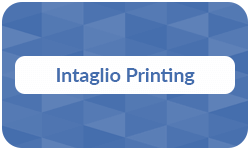
Printmaking consists of three main techniques: relief printing, intaglio printing, and planographic printing. Each of them relies on a different approach to transferring an image onto a sheet of paper, either raised surfaces, lowered ones, or flat ones. The following article will dive into the topic of intaglio printing, which works by transferring ink that fills engraved lines onto paper.
Inhaltsverzeichnis
Definition: Intaglio printing
Intaglio printing is a technique where an image is engraved into a baseplate before the lines are filled with ink and then pressed onto a sheet of printer paper. There are a few different techniques that autumn under this umbrella term: etching, engraving, aquatint, mezzotint, gravure printing, and pad printing.

Printing services at BachelorPrint
- Individual solutions & personal support
- High print quality & fast production times
- Wide range of print products for every need
Learn more!
Tools and materials
To produce a template for an intaglio print, there are several tools required. The first material needed is the baseplate, usually made from metal, preferably copper or any other softer type of metal, as well as sometimes plastic. For engraving, you will need a needle or a burin, which is a special tool, to incise the lines into the plate.
Etching, on the other hand, requires acid for the process. More tools required are:
- Press
- Rollers
- Brushes
- Printing ink
- Towel or blanket
- The right type of printer paper,
- Gloves (if the ink will be applied by hand)
- Pieces of cloth and newspaper to wipe excess ink
Process
The process of intaglio printing can be divided into four steps.

Carve design
Sketching on a piece of metal, often also coated with resin or wax, can be challenging. Therefore, many artists simply decide to engrave the design without transferring an image. Common techniques include engraving, etching, aquatint, gravure, or pad printing.
Apply ink
In the next step, ink is applied to the plate by using brushes, rollers, or simply gloved hands. It is necessary to ensure that the ink has seeped deeply into the decreased lines to have a satisfying result after printing.


Remove excess ink
Removing the excess ink is crucial to the intaglio printing process, as stains on the surface of the plate will show up in the final print. Therefore, the plate is first wiped with a cloth to get the majority of the ink off before removing all remnants with a piece of newspaper.
Print on paper
Before printing, the printer paper is usually dampened to ensure better printing quality. Thereafter, the paper is placed on top of the engraved plate and covered with a blanket or thick cloth, making sure that the pressure of the press is distributed evenly across the paper. After the printing process, the paper needs to be removed carefully to prevent smudging.

Engraving vs. etching
Engraving and etching are both very well-known techniques of intaglio printing. However, they must not be confused, since they follow two entirely different approaches.
Engraving
Engraving is the standard procedure in intaglio printing, where the lines are incised into the metal plate, which are then filled with ink.
Etching
Etching, on the other hand, requires acid as the medium that decreases the surface is can be filled with ink.
Copy and print from £0.08
- High-quality copies & prints for any project
- Vibrant color prints or sharp black & white prints
- Online copy and print services delivered straight to your door
Learn more!
FAQs
Intaglio printing is a printmaking process where the ink seeps into depressed surfaces and thus transfers the image onto the paper. In contrast to this, relief printing has the ink applied to the elevated surfaces, which print the image.
Generally, you differentiate between etching, engraving, aquatint, mezzotint, and gravure printing, which all follow different procedures while still relying on the basic concept of colouring the incised lines.
In intaglio printing, engraving and etching are the most popular techniques. While in engraving, a needle or burin incises lines into a metal plate; etching elevates the procedure by deepening those lines with acidic reactions. The plate is thereby protected from the acid with wax or resin and only scraped off on the to-be-inked surfaces. The acid then deepens those lines, making it easier for the ink to seep into them.